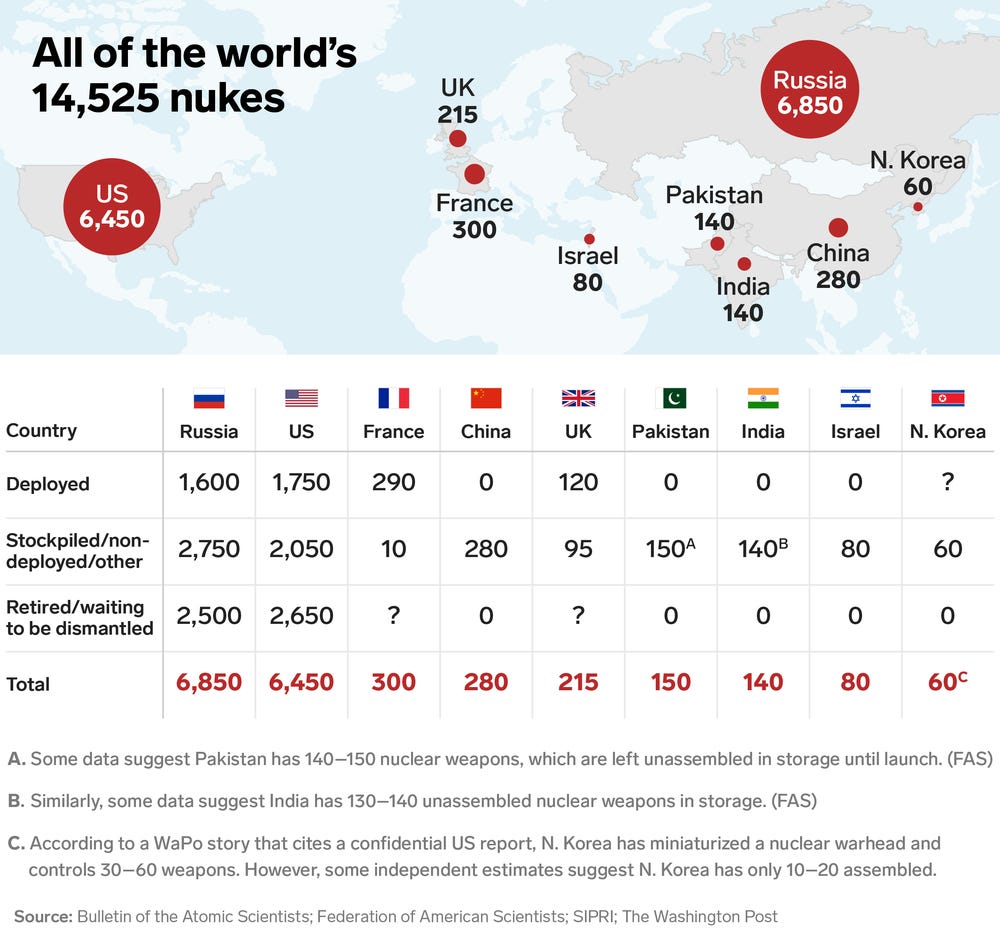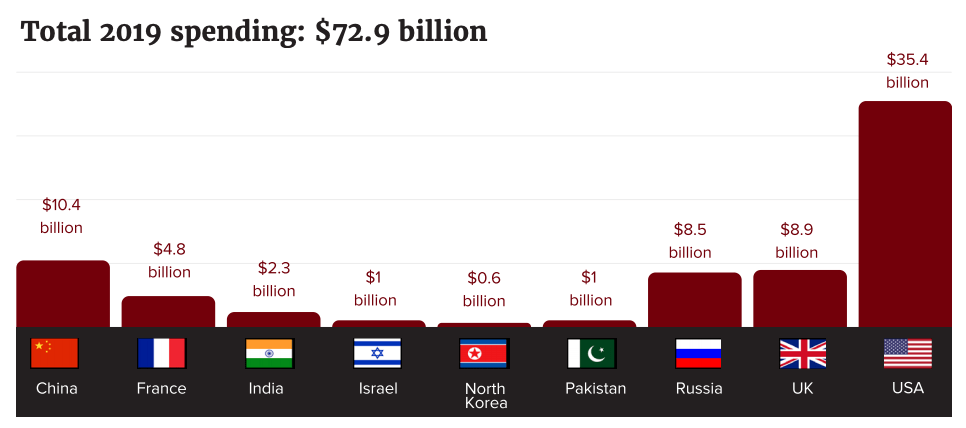
Biden has the power to order the launch of nuclear weapons, however Putin can’t do it on his own without the approval of either the Minister of Defence or the Chief of Staff.
In early 2019, more than 90% of the world’s 13,865 nuclear weapons were owned by Russia and the United States.
How Dangerous Are Nuclear Weapons?
Nuclear weapons produce enormous explosive energy. Their significance may best be appreciated by the coining of the words kiloton (1,000 tons) and megaton (1,000,000 tons) to describe their blast energy in equivalent weights of the conventional chemical explosive TNT.
Nuclear weapons are designed to release energy in an explosive manner as a result of nuclear fission, nuclear fusion, or a combination of the two processes. Fission weapons are commonly referred to as atomic bombs. Fusion weapons are also referred to as thermonuclear bombs or, more commonly, hydrogen bombs; they are usually defined as nuclear weapons in which at least a portion of the energy is released by nuclear fusion.
Which Countries Have Nuclear Missiles?
According to the BBC, countries currently have nuclear weapons: the US, UK, Russia, France, China, India, Pakistan, Israel and North Korea.

Russia is now developing the heavy SS-29, or Sarmat (RS-28), replacing the SS-18 (RS-20 V) at Uzhur in 2021 or 2022.
As of early 2021, Russia has a stockpile of nearly 4,500 nuclear warheads assigned for use by long-range strategic launchers and shorter-range tactical nuclear forces. Of the stockpiled warheads, approximately 1,600 strategic warheads are deployed: just over 800 on land-based ballistic missiles, about 624 on submarine-launched ballistic missiles, and 200 at heavy bomber bases. Another 985 strategic warheads are in storage, along with about 1,912 nonstrategic warheads. In addition to the military stockpile for operational forces, a large number – approximately 1,760 – of retired but still largely intact warheads await dismantlement, for a total inventory of approximately 6,257 warheads.
In June 2020, President Putin approved an update to the “Basic Principles of State Policy of the Russian Federation on Nuclear Deterrence,” which notes that “The Russian Federation considers nuclear weapons exclusively as a means of deterrence.” The policy lays out four conditions under which Russia could launch nuclear weapons:
- The “arrival of reliable data on a launch of ballistic missiles attacking the territory of the Russian Federation and/or its allies;
- The use of nuclear weapons or other types of weapons of mass destruction by an adversary against the Russian Federation and/or its allies;
- The attack by adversary against critical governmental or military sites of the Russian Federation, disruption of which would undermine nuclear forces response actions;
- The aggression against the Russian Federation with the use of conventional weapons when the very existence of the state is in jeopardy” (Russian Federation Foreign Affairs Ministry 2020). Russian nuclear weapons, 2021
Could Putin Launch Nuclear Missiles On His Own?
In Russia, there are three key persons as nuclear response code-holders: The President, Minister of Defence, and the Chief of the Staff, transmitting an Emergency Action Message (EAM) to the nuclear triad units to execute specific Major Attack Options or Limited Attack Options .
“Dead hand”, or “Perimeter”, is an alternative system for all units armed with nuclear weapons. It is a backup communication system, in case the key components of the “Kazbek” command system and the link to the Strategic Missile Forces are destroyed by a first-strike in accordance with the concept developed in the US called “Limited nuclear war”.
In order to ensure its functionality, the system was originally designed as fully automatic, and with the ability to decide on the adequate retaliatory strike on its own with no (or minimal) human involvement in the event of an all-out attack.
According to a developer of the system, it is a buffer against hasty decisions based on unverified information by the country’s leadership. Upon receiving warnings about a nuclear attack, the leader could activate the system, and then wait for further developments, assured by the fact that even the destruction of all key personnel with the authority to command the response to the attack could still not prevent a retaliatory strike, resulting in Mutual assured destruction or mutually assured destruction (MAD).
Thus, this eliminates the possibility of a false-alarm-triggered retaliation. A similar system existed in the U.S. known as the AN/DRC-8 Emergency Rocket Communications System (ERCS).
Could Biden Launch Nuclear Weapons On His Own?
In the US, the authority to launch a nuclear strike lies with the president alone.
The only obstacle could be no access to a briefcase, known as the nuclear football (the atomic football, the President’s emergency satchel, the Presidential Emergency Satchel, the button, the black box, or just the football), while away from fixed command centers, such as the White House Situation Room.
The world needs smarter nuclear policy systems, by removing the role of nuclear weapons in the national security strategy and elevating the role of intelligent algorithms in order to prevent human casualties.
The current US nuclear modernization program departs in several major ways from longstanding US nuclear policy: It elevates the role of nuclear weapons in US national security strategy, including plans for developing several new nuclear weapon capabilities, and resurrecting former nuclear capabilities that previous US presidents had wisely eliminated.
A Pandemic of Nuclear Weapons
The money spent on nuclear weapons has directly impacted the resources available to deal with the COVID-19 pandemic. In 2019, the nine nuclear-armed states (China, Democratic People’s Republic of Korea, France, India, Israel, Pakistan, Russia, United Kingdom, and United States) spent nearly $73 billion on their nuclear weapon systems. This comes to $138,699 spent on nuclear weapons per minute.

Several world leaders are demanding an end to nuclear weapon modernisation and a redirection of resources by relying on technology to save lives and protect the environment. The threat of a nuclear war is plausible. While the world may have fewer nuclear weapons today than it did 30 years ago, it doesn’t look like we’ll be seeing a complete end any time soon.
No comments:
Post a Comment